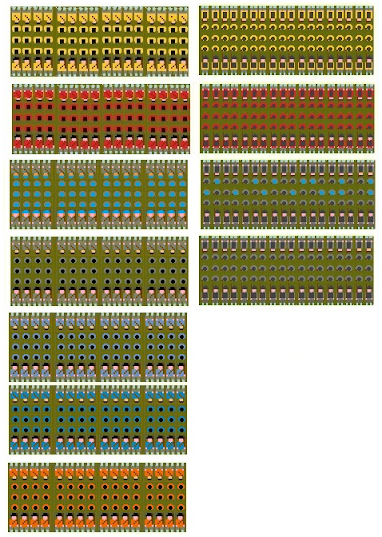A quick check of the period military manuals available to me online suggested that Pikemen formed for combat on a 1 yard frontage per man and shot on a 1.5 yard frontage plus some extra width for the gaps between corporalships (used to allow ranks to advance or retire if using introduction or extraduction shooting tactics). I decided that would be an additional 1.5 yards per four files as an approximation. Different armies had different numbers of files in those subdivisions of shot but I needed to standardise for ease of calculation and production of the printed unit paper skins. This wasn't an issue with the Altar of Freedom units as they were purely representational, butd here I'm going for something closer to a true unit footprint. Well anything else would be too easy wouldn't it!
 |
| Test layout for a Swedish three squadron brigade at 1mm to 1 yard. Sorry about the poor focus. |
That of course feeds straight back into the reading I had been doing on the various armies of the Thirty Years War. Not that everything I would like to know is easily available information. Who knew that there was so much missing detail in the period records and manuals! It's almost like the people back then had more important things to do than provide answers to sate my curiosity like fighting the Thirty Years War!
Next is the first of the messy stages cutting and gluing the matchstick cores to the bases. Originally I had thought that big brigade size bases was the way to go but it created some huge footprints. That would have required a major rewrite of the existing rule set and probably a completely different game altogether as some concepts would have been very different.
So I decided to go to the squadron level and group all a squadron's pike and shot into two or three separate bases. These wont be the standardised groups of 100 men per base so each group will get a combat rating of one per full hundred men represented and a half for any part left over which exceeds fifty men. I think I can see an easy way to make that work within the existing rules format but multiplying the combat hits by that factor rather than the number of bases. The key phrase there is “I think” with a strong emphasis on think!
So having got that debate out of the way it was out with the PVA glue. Because these units are six ranks deep I'm using four matchsticks in depth on a 1cm deep base. Frontage varies according to the number of files on each base. For pike after adding the wrapper I have used three matchsticks cut shorter than the unit so as to leave some soldiers showing all the way around. Stained brown with an ink and then with some silver dots added to represent the pike heads.
 |
| Prototype Pike block at tabletop range |
 |
| And in close up |
I don't think these are too bad at all. Musket blocks just have the match stick core and wrapper. The only change I made from the prototype is to make the wrapper a single item.











